General | May 16, 2023
How Strengthening Your Hips and Ankles Can Help With Knee Pain
Avram Baldoria-PHYSIOTHERAPIST-Bachelor of Science in Physical Therapy
Knee pain is a common musculoskeletal condition that affects people of all ages. Knee pain can be caused by various factors such as injury, inflammation, or degenerative conditions like osteoarthritis. However, strengthening the ankle and hip joints can help alleviate knee pain.
The ankle and hip joints play a significant role in maintaining proper alignment and stability of the knee joint. Weakness or instability in these joints can result in compensatory movements and abnormal loading of the knee joint, leading to pain and discomfort.
Strengthening the ankle joint involves exercises that target the muscles that control ankle movement, such as the gastrocnemius, soleus, and tibialis anterior muscles. These exercises can improve ankle strength and stability, thereby reducing the risk of ankle sprains and other injuries. Strong ankle muscles can also help prevent compensatory movements that may lead to knee pain.
Similarly, strengthening the hip joint can improve the stability and alignment of the knee joint. The hip joint is responsible for supporting the weight of the body during standing, walking, and other weight-bearing activities. Weakness in the hip muscles can result in abnormal movements of the knee joint, leading to pain and discomfort.
Exercises that target the hip muscles, such as the gluteus medius and maximus, can improve hip strength and stability. Strengthening the hip muscles can also improve balance and prevent falls, which can lead to knee injuries.
In addition to strengthening the ankle and hip joints, other strategies can help alleviate knee pain. These strategies include weight management, proper footwear, and proper alignment during activities such as walking and running.
Overall, strengthening the ankle and hip joints can be an effective strategy for reducing knee pain. By improving the stability and alignment of the knee joint, individuals can improve their overall function and quality of life. Book in for a consultation with one of our osteopaths or our physiotherapist to help manage your knee pain and determine the most appropriate exercises for your specific needs.
References:
- Earl JE, Hertel J. Lower-extremity muscle activation during the star excursion balance tests. J Sport Rehabil. 2001;10(2):93-104. doi:10.1123/jsr.10.2.93
- Reiman MP, Bolgla LA, Loudon JK. A literature review of studies evaluating gluteus maximus and gluteus medius activation during rehabilitation exercises. Physiother Theory Pract. 2012;28(4):257-268. doi:10.3109/09593985.2011.604981
- Powers CM. The influence of abnormal hip mechanics on knee injury: a biomechanical perspective. J Orthop Sports Phys Ther. 2010;40(2):42-51. doi:10.2519/jospt.2010.3337
- Riemann BL, Myers JB, Lephart SM. Sensorimotor system measurement techniques. J Athl Train. 2002;37(1):85-98.
- Shih YF, Chen CY, Lin HC, Hsieh LF, Chen CL. Effects of hip and ankle exercises on gait parameters in individuals with patellofemoral pain syndrome: a randomized controlled trial. J Sci Med Sport. 2019;22(1):49-54. doi:10.1016/j.jsams.2018.06.004


